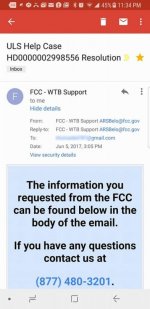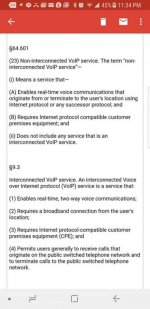History must be looked at to consider this...
Former restrictive wording (2015):
"§ 95.141 Interconnection prohibited.
No station in a GMRS system may be
interconnected to the public switched
telephone network except as and in accordance
with the requirements and restrictions
applied to a wireline control
link (see § 95.127). [53 FR 47717, Nov. 25, 1988]"
From a post I made in 2015:
Part 95, Section 141 refers to Part 95 Section 127. Section 127 has been removed. Without Section 127 for reference, I could see where a person not completely familiar with Part 95 might think that linking is prohibited. Section 127 stated that any equipment used must be compliant with Part 68, which is a standard for equipment used on the PTSN. The standard is designed to protect anyone working on the PSTN. Part 95, with full investigation, COMPLETELY allows for linking, just that if you do it over pone lines, you have to use Part 68 compliant equipment. It does not even come close to addressing linking via another GMRS frequency or utilizing IP linking (which is NOT the PTSN.)
The rules have been updated since then, but I have to agree with @RFI-EMI-GUY that the word "but" does indicate a tendency to a less restrictive stance oon the matter. I think this wording has been put in place simply because of questions submitted to the FCC and the plethora of threads debating this very subject. File under "our own worst enemy."
Former restrictive wording (2015):
"§ 95.141 Interconnection prohibited.
No station in a GMRS system may be
interconnected to the public switched
telephone network except as and in accordance
with the requirements and restrictions
applied to a wireline control
link (see § 95.127). [53 FR 47717, Nov. 25, 1988]"
From a post I made in 2015:
Part 95, Section 141 refers to Part 95 Section 127. Section 127 has been removed. Without Section 127 for reference, I could see where a person not completely familiar with Part 95 might think that linking is prohibited. Section 127 stated that any equipment used must be compliant with Part 68, which is a standard for equipment used on the PTSN. The standard is designed to protect anyone working on the PSTN. Part 95, with full investigation, COMPLETELY allows for linking, just that if you do it over pone lines, you have to use Part 68 compliant equipment. It does not even come close to addressing linking via another GMRS frequency or utilizing IP linking (which is NOT the PTSN.)
The rules have been updated since then, but I have to agree with @RFI-EMI-GUY that the word "but" does indicate a tendency to a less restrictive stance oon the matter. I think this wording has been put in place simply because of questions submitted to the FCC and the plethora of threads debating this very subject. File under "our own worst enemy."





